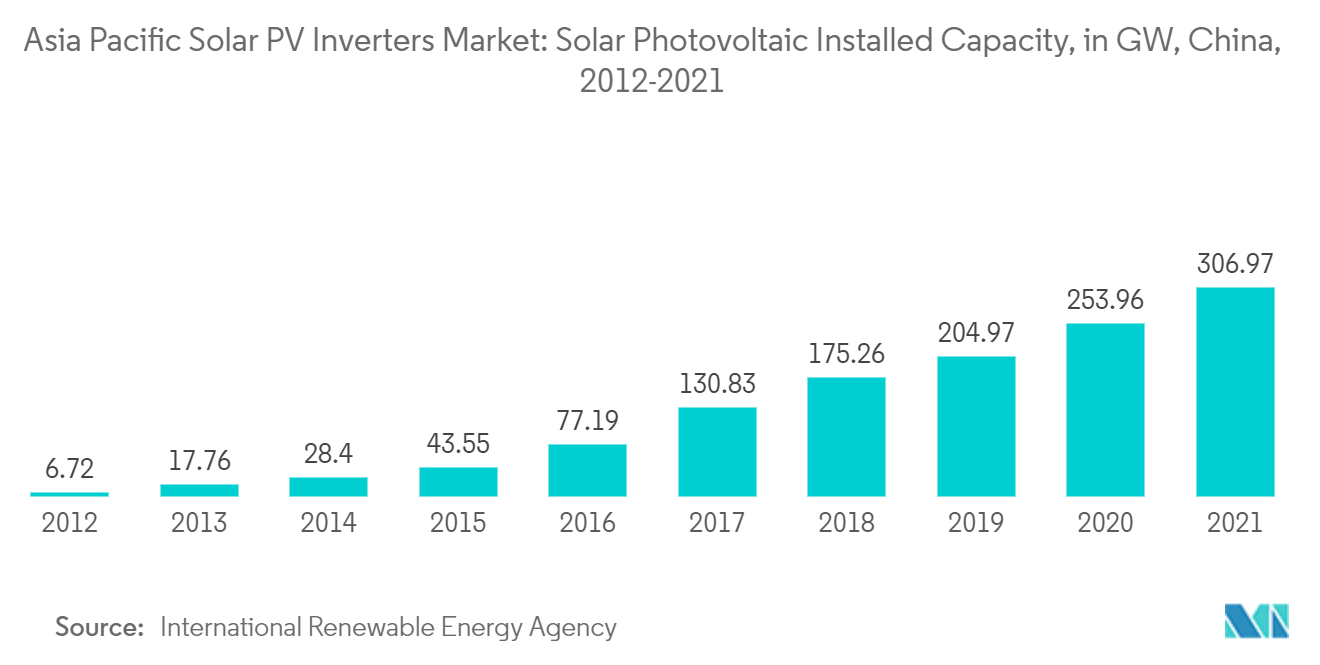Market Trends of Asia Pacific Solar PV Inverters Industry
This section covers the major market trends shaping the APAC Solar PV Inverters Market according to our research experts:
Central Inverters Segment Expected to Witness High Growth
- A central inverter is a large grid feeder. It is often used in solar photovoltaic systems with rated outputs over 100 kWp. Typically, floor or ground-mounted inverters convert DC power collected from a solar array into AC power for grid connection. These devices range in capacity from around 50 kW to 1 MW and can be used indoors or outdoors.
- Generally, a central inverter consists of one DC-AC conversion stage. Some inverters also have a DC-DC boost stage to increase their MPP (Maximum Power Point) voltage range. Low-frequency transformers are sometimes used to boost the AC voltage and provide isolation at the output. However, this reduces efficiency and increases the inverter's size, weight, and cost.
- In 2021, China installed the largest share of the world's new solar photovoltaic (PV) capacity, at 31% of the total capacity. In comparison, India accounted for about 7% of the world's solar PV installed capacity.
- In March 2022, Chinese inverter manufacturer Sungrow inaugurated its expanded scale of manufacturing capacity in India. The company developed and scaled the India factory to 10 GW/annum capacity for its customers locally and globally with lesser lead time and better service experience. At the inauguration ceremony, Sungrow launched new products in the string and central inverter categories, including models SG350HX and 1+X modular inverter.
- Therefore, the growing electricity demand, the government's efforts to decarbonize the power sector, and the declining costs of central inverters are expected to drive the segment in the coming years.

China to Dominate the Market
- China is home to nearly all the largest solar photovoltaic (PV) panel and equipment manufacturing companies and facilities globally, with about 70% of China's global solar PV manufacturing capacity. These companies also dominate other businesses in the solar energy supply chain. For example, the manufacture of polysilicon, ingot, and wafers for panels and equipment, such as inverters and related hardware.
- China is one of the major solar PV markets globally, and it is one of the largest markets for solar inverters. According to IRENA, in 2021, China had a total installed solar capacity of 306.97 GW. In 2021, China installed nearly 50 GW of solar power.
- The Chinese market has been growing considerably. According to the Ministry of Industry and Information Technology (MIIT), from April to May 2022, the country produced 31 GW of solar PV inverters. One of the primary factors driving the market is the burgeoning domestic demand.
- According to the China Photovoltaic Industry Association (CPIA), China installed a total of 54.88 GW solar capacity in 2021, up 13.9% year-on-year, and is expected to grow by 75-90 GW in 2022. Additionally, in 2021, Chinese-made products' export value hit a historic high at over USD 28 billion, witnessing a 72% year-on-year growth. It demonstrates the overseas demand for Chinese solar PV hardware, such as inverters.
- Due to several macroeconomic factors, such as lower labor and procurement costs enabling larger scales of economies, Chinese companies have driven down the global cost trends in solar PV hardware, including inverters. Due to this, domestic prices are among the lowest in the world, driving down international inverter costs.
- Hence, due to the above factors, China is expected to remain the world's largest solar energy and equipment market. The demand for solar inverters is expected to rise steadily during the forecast period.


